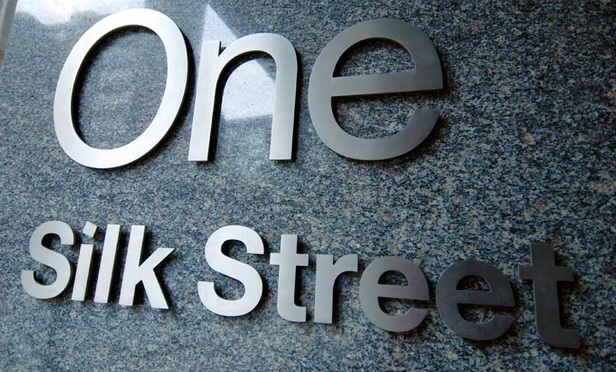Linklaters London partners face longer route to the top after lockstep shake-up
Partners in London will now take 12 years to reach the top of the equity instead of 10
December 13, 2016 at 08:29 AM
4 minute read
All Linklaters partners face a longer route to the top of the equity in London, following lockstep reforms voted through at the firm's November partnership conference.
The overhaul, ushered in by managing partner Gideon Moore and which will take effect from May 2017, means partners in London will take a minimum of 12 years to reach the top of the lockstep, compared to 10 years under the current system.
London partners will join the new lockstep at 14 points and progress by three points each year, to reach the top of the 50-point equity after 12 years.
This compares with a 10-year lockstep ranging from 10-25 points for London partners in core practice areas such as M&A at present. Those in non-core practices such as real estate are already on a 12-year lockstep, so the change puts all partners on equal footing.
The new lockstep also has a gate in the equity after eight years, intended to further slow progression. At this point, partners will be assessed to see if they are contributing sufficiently to keep climbing the ladder.
The scale of the ladder will vary depending on jurisdiction; for example, in Germany it will take partners at least 13 years to reach a lockstep capped at 45 points. Partners in Germany will also have two gates in the lockstep – one at six years and another at 10 years. It will in rare instances be possible for local partners to move beyond the cap, subject to performance.
The different ladders for each jurisdiction replace the country weightings of the current system, which sees Germany on a 0.9 country factor compared to London.
According to partners inside Linklaters, the primary goal of the reforms was to slow down progression through a top-heavy partnership, with the move intended in the longer term to increase the value of the top of the lockstep.
While partners already at the top of the lockstep will not face an automatic review of their position ahead of the new system coming into place, all partners will see their position reviewed after five years at the top of the lockstep.
This could mean older partners at the top of the equity having their points cut in order to keep the overall profitability of the firm up and make it easier to promote younger partners.
One ex-partner said: "The key issue that Linklaters has is that it is over-equitised, something like 70% of partners in London are at the top of the lockstep."
Some Linklaters partners have suggested the overhaul is also intended to reduce the need for large partnership restructurings, by slowing the length of time it takes to reach the top and holding partners at gates.
When partners do hit gates, the performance of their wider practice group or office will be looked at to decide how equity points are best allocated.
The bulk of the magic circle have overhauled their lockstep in recent years, with Allen & Overy, Clifford Chance and Freshfields Bruckhaus Deringer all making changes. These efforts have focused on making it easier to reward star partners and therefore stay competitive in markets where there is pressure for talent, such as the US and London, as well as increasing flexibility lower down.
Freshfields, for example, introduced a two-tier lockstep system, with a lower ladder in some jurisdictions. The firm has also been willing to break its lockstep at the top to bring in star partners in New York, Asia and London – something that Linklaters has avoided in its latest overhaul.
A former partner said earlier plans for the lockstep reform were more radical: "The initial proposal was a rework of the entire lockstep," he said, claiming that these proposals were watered down by a "silent majority" of senior partners.
Another ex-partner argued that as a result, the reforms do not go far enough in keeping Linklaters competitive. "It is an interim, compromise step on the route to something more substantial," he said, adding: "The problem with all these things is you are either lockstep or you are not. If you are not then pretending that you are is just a farce."
Linklaters declined to comment.
This content has been archived. It is available through our partners, LexisNexis® and Bloomberg Law.
To view this content, please continue to their sites.
Not a Lexis Subscriber?
Subscribe Now
Not a Bloomberg Law Subscriber?
Subscribe Now
NOT FOR REPRINT
© 2025 ALM Global, LLC, All Rights Reserved. Request academic re-use from www.copyright.com. All other uses, submit a request to [email protected]. For more information visit Asset & Logo Licensing.
You Might Like
View All
CMS Sheds 15 Real Estate Lawyers Following Second Redundancy Round in 18 Months
2 minute read
Former Dentons, Baker McKenzie Partners Join Hong Kong Boutique Linked to China's Yingke

Trump's Second Term Sparks Unusual Alliances Between US and European Law Firms
3 minute read
RPC Asia Head Antony Sassi Appointed as Global Managing Partner
Trending Stories
Who Got The Work
J. Brugh Lower of Gibbons has entered an appearance for industrial equipment supplier Devco Corporation in a pending trademark infringement lawsuit. The suit, accusing the defendant of selling knock-off Graco products, was filed Dec. 18 in New Jersey District Court by Rivkin Radler on behalf of Graco Inc. and Graco Minnesota. The case, assigned to U.S. District Judge Zahid N. Quraishi, is 3:24-cv-11294, Graco Inc. et al v. Devco Corporation.
Who Got The Work
Rebecca Maller-Stein and Kent A. Yalowitz of Arnold & Porter Kaye Scholer have entered their appearances for Hanaco Venture Capital and its executives, Lior Prosor and David Frankel, in a pending securities lawsuit. The action, filed on Dec. 24 in New York Southern District Court by Zell, Aron & Co. on behalf of Goldeneye Advisors, accuses the defendants of negligently and fraudulently managing the plaintiff's $1 million investment. The case, assigned to U.S. District Judge Vernon S. Broderick, is 1:24-cv-09918, Goldeneye Advisors, LLC v. Hanaco Venture Capital, Ltd. et al.
Who Got The Work
Attorneys from A&O Shearman has stepped in as defense counsel for Toronto-Dominion Bank and other defendants in a pending securities class action. The suit, filed Dec. 11 in New York Southern District Court by Bleichmar Fonti & Auld, accuses the defendants of concealing the bank's 'pervasive' deficiencies in regards to its compliance with the Bank Secrecy Act and the quality of its anti-money laundering controls. The case, assigned to U.S. District Judge Arun Subramanian, is 1:24-cv-09445, Gonzalez v. The Toronto-Dominion Bank et al.
Who Got The Work
Crown Castle International, a Pennsylvania company providing shared communications infrastructure, has turned to Luke D. Wolf of Gordon Rees Scully Mansukhani to fend off a pending breach-of-contract lawsuit. The court action, filed Nov. 25 in Michigan Eastern District Court by Hooper Hathaway PC on behalf of The Town Residences LLC, accuses Crown Castle of failing to transfer approximately $30,000 in utility payments from T-Mobile in breach of a roof-top lease and assignment agreement. The case, assigned to U.S. District Judge Susan K. Declercq, is 2:24-cv-13131, The Town Residences LLC v. T-Mobile US, Inc. et al.
Who Got The Work
Wilfred P. Coronato and Daniel M. Schwartz of McCarter & English have stepped in as defense counsel to Electrolux Home Products Inc. in a pending product liability lawsuit. The court action, filed Nov. 26 in New York Eastern District Court by Poulos Lopiccolo PC and Nagel Rice LLP on behalf of David Stern, alleges that the defendant's refrigerators’ drawers and shelving repeatedly break and fall apart within months after purchase. The case, assigned to U.S. District Judge Joan M. Azrack, is 2:24-cv-08204, Stern v. Electrolux Home Products, Inc.
Featured Firms
Law Offices of Gary Martin Hays & Associates, P.C.
(470) 294-1674
Law Offices of Mark E. Salomone
(857) 444-6468
Smith & Hassler
(713) 739-1250









